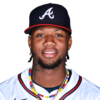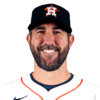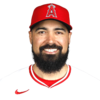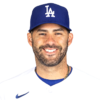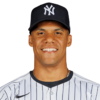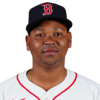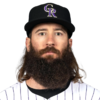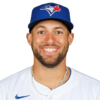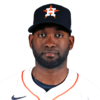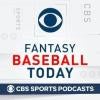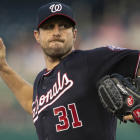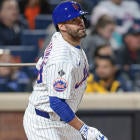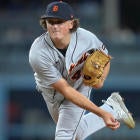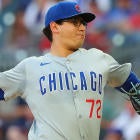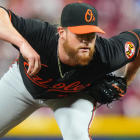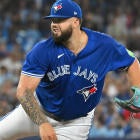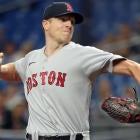Right around the All-Star break, I took a timeout from the 2019 rat race to imagine what the first two rounds of a 2020 draft might look like.
How is it possible so much has changed since then?
I'll tell you how. For all the home run records being set, nobody's challenging for 73 or 70 or 61 or whatever individual number would impress you. It's more evenly distributed than that, which means that what the player pool has to offer right now is like an ampm convenience store: too much good stuff. There's so much high-end talent that sorting out 1-50, much less 1-24, requires an excruciating degree of parsing, to the point that the justification for a two- or even three-round separation between players is sometimes fairly arbitrary.
It should make for less of a consensus than ever once the draft prep season is in full swing and full-scale rankings and mock draft results are popping up everywhere.
It also has me asking myself where a scarcity will reveal itself soonest, figuring that's the most sensible way to navigate the surplus, and the answer should be obvious. What's the position we all (yes, every single one of us) have struggled to fill all season long, seeing every trade offer denied and every waiver wire hopeful flattened?
It's starting pitcher, of course. There are a couple dozen who are genuinely good and a couple dozen more who pass for good most days. Everyone else stinks.
Is there a case to be made, then, given the outrageous number of hitters capable of delivering early-round production at every position, for drafting nothing but good pitchers until they're all gone? My instincts tell me that's taking it too far, though I'll need more draft reps to say for sure.
For now, I'm making a concerted effort to ask myself at every turn if the hitter I'm drafting here is genuinely irreplaceable, and if not, I'm taking a pitcher instead.
Of course, it still kind of feels like I'm banking on an unspoken agreement between longtime Fantasy players not to go hog-wild for pitching early just because ... no one ever does. And maybe by the time drafting begins in earnest, I'll be shaken from my trance to discover that a paradigm shift has indeed taken place and high-end starting pitchers are the only true currency.
We'll see. But here's a starting point, if nothing else.
| 1 |
Mike Trout
Los Angeles Angels CF
|
| Some years he doesn't run as much as others, but Mike Trout always produces like one of the tip-top players in Fantasy. Those who get cute opting for the one guy who happened to outperform him the year before always come to regret it. | |
| 2 |
Christian Yelich
Milwaukee Brewers RF
|
| Christian Yelich happened to be that one guy outperforming Trout this year, but his season of course ended on a sour note with a fractured kneecap. Back-to-back years of MVP-caliber production certainly counts for something, but all of the incredible heights he reached this year are known to be within Trout's reach as well -- and without the lingering injury question. | |
| 3 |
Cody Bellinger
Los Angeles Dodgers RF
|
| Some would make the case for Ronald Acuna or Mookie Betts over Cody Bellinger, whose batting average has fallen off in the second half. But he has been hitting the ball just as hard and nearly as often, his improved strikeout rate remaining the greatest testament to his breakout. The gap between batting average and xBA would suggest first-half Bellinger is closer to the real one. | |
| 4 |
Ronald Acuna
Atlanta Braves CF
|
| Ronald Acuna only runs when he's batting leadoff, but manager Brian Snitker says that's where he intends to keep him, which makes the 21-year-old the safest bet for stolen bases among the players listed so far. He may not have quite the same batting average potential, his strikeout rate being what it is, but it's also fair to assume he hasn't revealed his ultimate ceiling yet ... and that's coming off a near 40-40 season. | |
| 5 |
Mookie Betts
Boston Red Sox RF
|
| Mookie Betts' plate discipline gives him such a high floor and makes him such a prolific run-scorer at the top of a loaded lineup that even when he falls short of the MVP standard he set in both 2016 and 2018, he's still obvious first-round material. The dip in stolen bases is of some concern in traditional 5x5 leagues, but in points leagues, he's in the mix to go third overall. | |
| 6 |
Max Scherzer
Washington Nationals SP
|
| Missing most of the second half with a back issue shines a light on Max Scherzer's 35 years of age and reminds us all that eventually the mileage will catch up to him. But assuming he pulls it together here in September, there's only one other pitcher who can match his combination of workload and effectiveness. | |
| 7 |
Justin Verlander
Houston Astros SP
|
| That's the one! Justin Verlander has obviously been the steadier and healthier of the throwback aces in 2019, but if you think Scherzer's 35 years of age at the start of next year is a major red flag, then Verlander's 37 is like a deal with the devil. Still, you'll gamble on getting incomparable impact from the weakest position knowing the caliber of hitter that'll be available to you later. | |
| 8 |
Gerrit Cole
Houston Astros SP
|
| There's little reason to think the strides Gerrit Cole has made with the Astros the past two years will be undone if he signs with a different team this offseason, and the double digit-strikeout efforts have been even more plentiful for him than for Scherzer and Verlander. He's not quite at their level in terms of workload, but he may have surpassed both in inning-for-inning effectiveness this year. | |
| 9 |
Francisco Lindor
Cleveland Indians SS
|
| Francisco Lindor isn't as clear of a standout anymore at what has become an impossibly loaded shortstop position, but the range of his contributions gives him both a higher floor and a higher ceiling than the others. The power and contact skills are well established at this point, and he has twice over proven to be a prolific base-stealer as well. | |
| 10 |
Anthony Rendon
Washington Nationals 3B
|
| At first glance, Anthony Rendon's numbers may seem too good to be true, but it turns out that when you pair his always elite plate discipline with an improved hard-hit and barreled-ball rate, he's legitimately a top-five hitter, as supported by his xwOBA and xBA. But are those sustainable gains, and will he ever go a whole year without an IL stint? | |
| 11 |
Nolan Arenado
Colorado Rockies 3B
|
| Safer money's on Nolan Arenado, who's still a four-category stud and will remain so for the foreseeable future now that the Rockies have locked him up long-term. So go ahead and take him over Rendon in a traditional 5x5 categories league. But in points leagues, it's now two years in a row that Rendon has outperformed Arenado on a per-game basis -- and this year, significantly so. | |
| 12 |
Freddie Freeman
Atlanta Braves 1B
|
| Always a safe bet for a .300 batting average, Freeman has been flirting with massive power production for the past few seasons and has finally made good on it this year. First base is loaded with sluggers in the most power-laden era the game has ever known, but it's what Freeman does on balls in play that sets him apart. | |
| 13 |
Alex Bregman
Houston Astros 3B
|
| Walking more than he has struck out for a second straight year, Alex Bregman's plate discipline, like Rendon's, is enough of a differentiator to move him ahead of Arenado in points leagues, making him a clear first-rounder in that format. And the gap between the two is narrowing in traditional 5x5 leagues, though Arenado is probably good for a few more home runs. | |
| 14 |
Trevor Story
Colorado Rockies SS
|
| Coming into the year, Trevor Story was thought to be too risky to go this high even though the numbers warranted it, but now that he's proven the strikeout and stolen bases gains are here to stay, his projected five-category output isn't so different from Lindor's. It's still a sizable difference in strikeout rate, though. | |
| 15 |
Jacob deGrom
New York Mets SP
|
| While he has gotten burned by win-loss record for a second straight year, Jacob deGrom has mostly backed up his Cy Young-winning 2018 — at least as much as anyone could reasonably expect. He's just a quarter-step behind Scherzer, Verlander and Cole in bat-missing ability. | |
| 16 |
Chris Sale
Boston Red Sox SP
|
| Chris Sale is no doubt a controversial pick coming off a season defined by elbow issues, an inflated ERA and a wonky win-loss record, but if you're fully invested in the idea that stud hitters will be available throughout the draft, you'll risk a little more to get the highest possible impact at starting pitcher. Sale ranks behind only Cole and Scherzer with a 2.94 xFIP, behind only Cole with 13.3 K/9, and he'll end up having more starts with double-digit strikeouts than either Verlander or Scherzer. | |
| 17 |
J.D. Martinez
Boston Red Sox DH
|
| It hasn't been a precipitous fall from 2018 for J.D. Martinez, but with so little separating these early-round hitters, it's enough to drop him a full round in the rankings. His 32 years of age presents an additional risk factor as well. | |
| 18 |
Juan Soto
Washington Nationals LF
|
| An improved launch angle has put to rest whatever doubts may have arisen regarding Juan Soto's power potential during his rookie season, presenting a bat with shockingly few weaknesses heading into his age-21 season. It's still the plate discipline that stands out most of all, but the batting average potential is so high that the gap between his 5x5 and points-league value is thin. | |
| 19 |
Rafael Devers
Boston Red Sox 3B
|
| The breakthrough for Rafael Devers has come a year later than many expected but has surpassed even the most optimistic projections, putting him in the mix for top billing at the deepest position in Fantasy as he enters his age-23 season. It's mostly legit, too, but his on-base skills aren't quite on the level of Rendon or Bregman. | |
| 20 |
Xander Bogaerts
Boston Red Sox SS
|
| Elevating the ball continues to work wonders for Xander Bogaerts, whose power production has taken another step forward by virtue of him doing even more of it this year. Already blessed with good contact skills and an optimal supporting cast, there's no reason why the 26-year-old shouldn't remain one of the elites at the position next year. | |
| 21 |
Trea Turner
Washington Nationals SS
|
| Trea Turner is sure to go earlier than this in traditional 5x5 leagues, but I have to admit the breathless pursuit of stolen bases has begun to wear on me. Yeah, they're scarce, but you only need so many of them. And the caliber of hitter you'd be giving up for them prior to this point just doesn't work for me. | |
| 22 |
Charlie Blackmon
Colorado Rockies RF
|
| How replete is this player pool in high-end hitters? So much that I've seen Charlie Blackmon, in a year he's doing Charlie Blackmon-like things, go as late as Round 4 in early mock drafts. Maybe he's being downgraded for being in his mid-30s, which is reasonable, but I'm kind of already downgrading him here. With Coors Field as his home, another .315 batting average with 30 homers is to be expected. | |
| 23 |
Ketel Marte
Arizona Diamondbacks CF
|
| Nobody saw this much of a breakthrough coming for Ketel Marte, and so we've spent most of the year anticipating a dropoff. But his numbers have only gotten better in the second half, solidifying his No. 1 standing at what's probably the weakest of the infield positions. And as little as he strikes out, what sort of floor could there be? | |
| 24 |
Jose Altuve
Houston Astros 2B
|
| It's probably safe to rule out a sizable steals total for Jose Altuve seeing as he hasn't delivered one since 2017, but the former first-round lock has bounced back nicely at the dish after persistent leg issues had him once again looking like a bust in the first half. There's some risk here, but he's still just 29 and presents a bankable batting average profile at a relatively weak position. | |
Fernando Tatis
San Diego Padres SS
|
| The excessive strikeout rate probably would have caught up to Fernando Tatis if injuries hadn't ended his season first, and his stolen bases pace slowed considerably over the course of the year. |
Shane Bieber
Cleveland Indians SP
|
| It woudn't be wrong to take Shane Bieber in the second round, but with Walker Buehler, Mike Clevinger, Clayton Kershaw, Lucas Giolito, Stephen Strasburg, Aaron Nola, Patrick Corbin and so many other similarly regarded pitchers still on the board, it seems unnecessary to elevate him in that way. |
George Springer
Houston Astros CF
|
| George Springer's 2019 production indeed warrants a second-round pick, but someone has to be the odd man out. Seeing as he'll be 30 next year and has an up-and-down track record, he seems less promising than the others. |
Yordan Alvarez
Houston Astros DH
|
| Yordan Alvarez will be DH-only next year, which makes him an especially difficult fit in the typical Head-to-Head lineup. And while his world-beating production reveals no obvious red flags, a higher degree of skepticism is always warranted for a player with less than a full season under his belt. |
Jose Ramirez
Cleveland Indians 3B
|
| Jose Ramirez was the consensus third overall pick this year and looked like it from about mid-June on, once again flashing five-category potential with a microscopic strikeout rate. But he was so bad before then -- a slump that dated back to last August -- that it's hard to know exactly what you're getting, especially since an injury ended things prematurely. |
Aaron Judge
New York Yankees RF
|
| Aaron Judge is hitting the ball as hard as ever and beginning to make up ground in what was a curiously low home run pace. But it's less the drop in production than the persistent injuries for a player whose big build might make him vulnerable to breakdowns. There's just too many high-end hitters for you to take on a potential headache so early. |










